
PREV ARTICLE
NEXT ARTICLE
FULL ISSUE
PREV FULL ISSUE
SELECTIONS FROM THE POGUE COLLECTION, PART VHere are some lots that caught my eye in the upcoming Stack's Bowers Pogue Sale V. Here are some short excerpts from the catalog - be sure to see the complete descriptions
online. -Editor
Lot 5091: 1793 Liberty Cap Cent 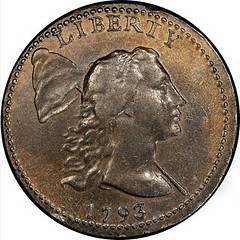 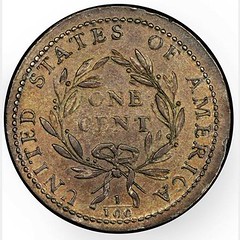 "He was a modeller in clay and practiced die-sinking, which last gained him the appointment, shortly before his death, of die-sinker to the Mint. The yellow fever of 1793 deprived his country of his abilities." Among the most problem-free of the high grade 1793 Liberty Cap cents, this coin ideally showcases the Liberty Cap design of Joseph Wright. As a young portrait painter studying in London, just 26 years old, Wright was dispatched to Paris to paint Benjamin Franklin. He spent much of the first half of 1782 in Passy, the Paris suburb that served as Franklin's home in France. In March 1782, Franklin conceived a medal that would have an enormous impact on the future of American coinage and the numismatic legacy of Joseph Wright. Many, perhaps most, of the leaders of the American Revolution were given examples of the Libertas Americana medal. Jefferson's was displayed in a frame at Monticello and described in his inventory of art as "a medal by Doctor Franklin." Washington's, struck in silver, was housed in a sumptuous box that contained a set of medals struck in France to commemorate the Revolution. If Wright didn't own one personally, the odds are good that others in his circle did, likely including Mint Director David Rittenhouse. Research by Bill Eckberg, published in Penny-Wise in September 2010, has shown that the 1793 Liberty Cap cents were struck on July 18 and July 22, indicating that the dies must have been executed some time earlier. The fruits of the Mint's labor for those two days amounted to 11,056 cents, representing the sum total of the 1793 Liberty Cap cent production, all delivered to the Mint's treasurer on September 18. By the day they were inspected, counted, and turned over for distribution, Joseph Wright was dead, a victim of the plague that turned Philadelphia vacant during the late summer doldrums for years into the early 19th century: yellow fever. To read the complete lot description, see: Lot 5093: 1794 Liberty Cap Cent, Head of 1793 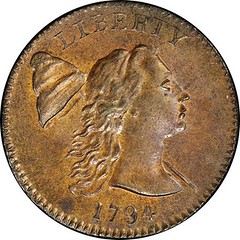 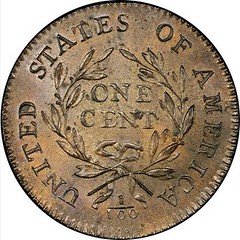 If 1794 cents are large cent royalty, this coin is the Crown Prince of this date. Its quality is incomparable and its provenance is perhaps even better. The list of owners of this coin is made more astounding by the fact that it spent seven decades in the trays of the Garrett Collection, housed for most of that time at Evergreen House in Baltimore. Before this coin was sold at public auction in 2013, it had not been put up for bids in over a century. Every link in its provenance chain tells a story. One sale was delayed by President Lincoln's assassination. Another would have never occurred but for derring-do and an academic appetite for ancient coins that exceeded that for coins of the United States. It has been described as "entirely uncirculated" by W. Elliot Woodward (and by Frossard, who later borrowed this same phrase), "a beauty in every respect" by David Proskey, "as far as I know, unique" by Dr. Edward Maris, and a "blazer" by Ted Naftzger. J.N.T. Levick, more quaintly, noted that the coin was "very fine, or quite Unc." When Ted Naftzger wrote to John W. Adams to ask, "What's the chance of my seeing a few of your lovely '94s one more time?" this coin was literally at the top of his list. Its story begins, of course, in 1794, after the death of engraver Joseph Wright. Wright's new but familiar design, directly inspired by Augustin Dupre's 1783 Libertas Americana medal, was used on the Liberty Cap cents of 1793. The obverse hubs Wright made, depicting the head a young woman superimposed upon a liberty pole and cap, outlived him. This classic design would be reimagined by Robert Scot, but not before three obverse dies were sunk with Wright's head of Liberty. Those dies, used to strike Sheldon numbers 17, 18, 19, and 20, are known today as the Head of 1793. To read the complete lot description, see: Lot 5067: 1811 Classic Head Half Cent 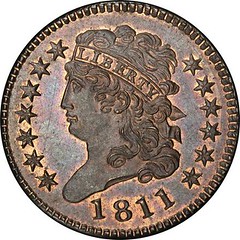 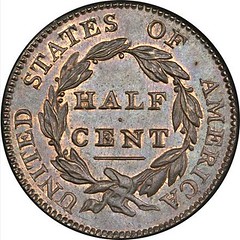 Coined from the earliest known state of these dies, this coin displays all the delicate relics of the die's production that would be lost on a lower grade coin. The portrait shows many criss-crossing raised lapping lines, and others are seen descending into the field from her nose and lips, stretching into the fields above and below the bust truncation, and covering the reverse fields in a mostly vertical fashion. There are noteworthy raised die lines right of the top of U of UNITED and spanning from below C of CENT to the wreath below CA. This is Breen's Die State I and Manley 1.0. Most specialists in the half cent series would be overjoyed to own any 1811 with a modicum of visual appeal. Most are well worn, and few among them are beautiful. "Most 1811 C-1 half cents are in grades below Fine," according to Manley, and the somewhat more common Cohen-2 is even scarcer in high grades than this variety. PCGS has graded a Mint State example of this date on just five occasions. The two best, of which this is the finer, were in the Missouri Cabinet Collection: this MS-66 RB (PCGS) Cohen-1 and a MS-65+ BN Cohen-2. The McGuigan Collection includes an MS-62 BN Cohen-2, and an MS-63 BN (PCGS) was sold in April 2014. The Norweb Cohen-1, the only example of this variety that could rival the present example, does not appear to have been certified or offered publicly since 1987. NGC has never graded a single example of this date in Mint State. Even before cannon had been pointed at Fort Sumter, 1811 half cents were a desirable commodity. Montroville W. Dickeson, as early as 1859, described them as "rare and valuable, as they are to be found but in few cabinets." Today, it remains a key to the series. Rick Coleman summed this coin's appeal well when describing its first place finish at the 1998 Half Cent Happening: "R. Tettenhorst's 1811 C1 was the star of the show. As Mike George commented, 'Once you see that coin, it changes everything.' I was pleased to have it present. There is nothing like a proof like, Mint State, red brown 1811 C1 to ensure that the Happening is a success." To read the complete lot description, see: Lot 5037: 1800 Draped Bust Dollar 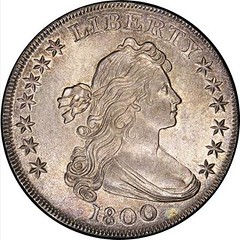 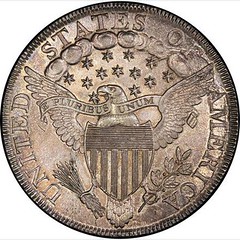 "The Director is sorry to observe, that the practice of melting down the coin of the United States, by workmen in gold and silver, is, he fears, becoming too common, to the manifest loss of the United States. As there are not any laws prohibiting it, every one is left to his own discretion, which, from the certainty of the standard, becomes so great a convenience, if not a pecuniary advantage, as to render the prevalence of the practice almost beyond a doubt, if not prohibited by law." The year 1800 was an inflection point in the history of the United States Mint and the dollar denomination. After mintages of 327,536 and 423,515 in 1798 and 1799, the number of dollars decreased in 1800 to fewer than 221,000. The annual mintage would not top 100,000 pieces again for more than 40 years. The Mint institution endured similar ups and downs. After five years of gold and silver coin production, and nearly a decade of operation, the Philadelphia Mint was threatened by the impending removal of the national capital to its new location on the banks of the Potomac. Elias Boudinot warned President John Adams, "The doubtful consequences of a removal must strike every person acquainted with the business of the mint, as it is in a great measure supported by the bullion passing through the different banks of this city." Boudinot understood that transplanting the Mint from the biggest commercial center in the nation to a new city far from the corridors of economic power would have devastating consequences. Further, the Mint's products were disappearing from circulation faster than they could be replaced, as the gyrations of the international market for gold and silver created premiums that made the export and melting of United States coins more and more profitable for corporate entrepreneurs. Boudinot successfully lobbied Congress for a reprieve from the impending move, receiving a two-year stay of execution on March 3, 1801. Further five-year renewals passed Congress in 1803, 1808, 1813, 1818, and 1823, but it wasn't until the Act of May 19, 1828 that the Mint was allowed to "continue ... at Philadelphia until otherwise provided by law." To read the complete lot description, see:  Wayne Homren, Editor The Numismatic Bibliomania Society is a non-profit organization promoting numismatic literature. See our web site at coinbooks.org. To submit items for publication in The E-Sylum, write to the Editor at this address: whomren@gmail.com To subscribe go to: https://my.binhost.com/lists/listinfo/esylum All Rights Reserved. NBS Home Page Contact the NBS webmaster 
|